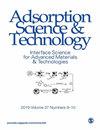Development of Active CO2 Emission Control for Diesel Engine Exhaust Using Amine-Based Adsorption and Absorption Technique
IF 2.8
4区 工程技术
Q2 CHEMISTRY, APPLIED
引用次数: 22
Abstract
Diesel-powered transportation is considered an efficient method of transportation; this sees the increase in the demand for the diesel engine. But diesel engines are considered to be one of the largest contributors to environmental pollution. The automobile sector accounts for the second-largest source for increasing CO2 emission globally. In this experiment, a suitable postcombustion treatment to control CO2 emission from IC engine exhaust is developed and tested. This work focuses to control CO2 emission by using the chemical adsorbent technique in diesel engine exhaust. An amine-based liquid is used to adsorb the CO2 molecules first and absorb over the amines from the diesel engine exhaust. Three types of amino solutions (L-alanine, L-aspartic acid, and L-arginine) were prepared for 0.3 mole concentrations, and the CO2 absorption investigation is performed in each solution by passing the diesel exhaust. A suitable CO2 adsorption trap is developed and tested for CO2 absorption. The experiments were performed in a single-cylinder diesel engine under variable load conditions. The eddy current dynamometer is used to apply appropriate loads on the engine based on the settings. The AVL DIGAS analyzer was used to measure the CO2, HC, and CO emissions. An uncertainty analysis is carried out on the experimental results to minimize the errors in the results. The effective CO2 reduction was achieved up to 85%, and simultaneous reduction of HC and CO was also observed.胺基吸附吸收技术用于柴油机尾气主动CO2排放控制的研究进展
柴油动力交通被认为是一种高效的交通方式;这表明对柴油发动机的需求在增加。但柴油发动机被认为是造成环境污染的最大因素之一。汽车行业是全球二氧化碳排放量增加的第二大来源。在本实验中,开发并测试了一种合适的燃烧后处理方法来控制内燃机排气中的CO2排放。本文的研究重点是利用化学吸附剂技术控制柴油机尾气中的CO2排放。首先使用胺基液体吸附二氧化碳分子,并从柴油发动机排气中吸收胺。制备了三种浓度为0.3 mol的氨基酸溶液(l -丙氨酸、l -天冬氨酸和l -精氨酸),并通过柴油机尾气对每种溶液进行CO2吸收研究。研制了一种合适的CO2吸附捕集器,并进行了CO2吸附试验。实验在变负荷条件下的单缸柴油机上进行。涡流测功机用于根据设置对发动机施加适当的负载。采用AVL DIGAS分析仪测量CO2、HC和CO排放量。对实验结果进行了不确定度分析,以尽量减少实验结果中的误差。CO2的有效减排量可达85%,HC和CO同时减少。
本文章由计算机程序翻译,如有差异,请以英文原文为准。
求助全文
约1分钟内获得全文
求助全文
来源期刊

Adsorption Science & Technology
工程技术-工程:化工
CiteScore
5.00
自引率
10.30%
发文量
181
审稿时长
4.5 months
期刊介绍:
Adsorption Science & Technology is a peer-reviewed, open access journal devoted to studies of adsorption and desorption phenomena, which publishes original research papers and critical review articles, with occasional special issues relating to particular topics and symposia.
 求助内容:
求助内容: 应助结果提醒方式:
应助结果提醒方式:


